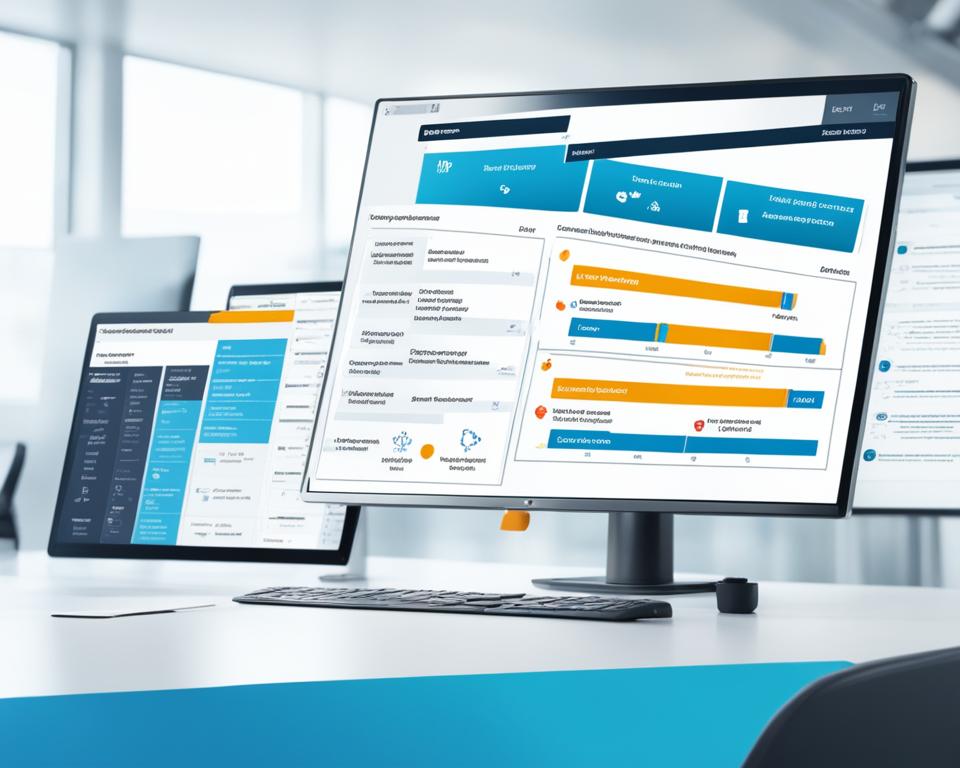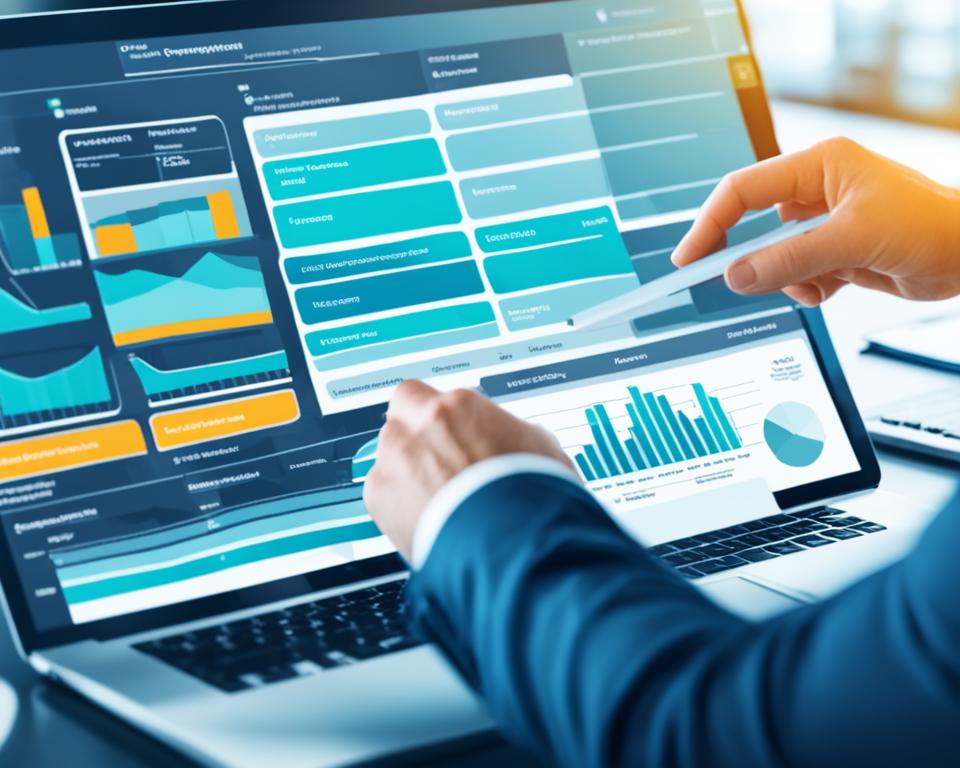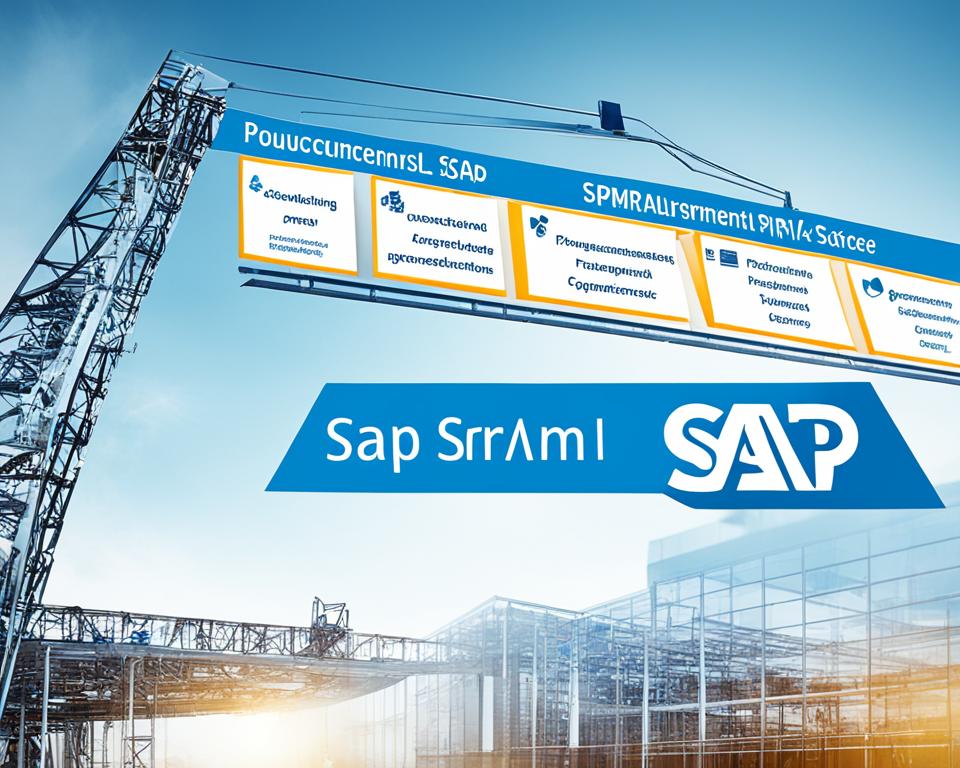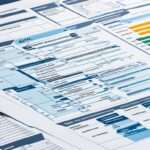Have you ever seen some companies manage their suppliers with ease, while keeping costs low? They use advanced software like SAP SRM. This tool changes how businesses handle Supplier Relationship Management. It makes things run smoother and more efficiently.
In this article, we’ll look at how SAP SRM helps streamline procurement. It also improves collaboration between buyers and suppliers. This leads to better decisions and big cost savings.
Key Takeaways
- SAP SRM significantly improves supplier collaboration.
- Effective Supplier Relationship Management leads to operational efficiency.
- Modern procurement software streamlines complex processes.
- Implementing SAP SRM can result in substantial cost savings.
- Strategic sourcing is enhanced through SAP SRM functionalities.
Understanding SAP SRM and Its Importance in Procurement
SAP SRM stands for SAP Supplier Relationship Management. It’s a key tool for making the procurement process smoother. By using SAP SRM, companies can handle their supplier interactions better. This leads to better negotiation results and more value for the business.
Procurement is very important for any business. A good procurement strategy helps companies get the best prices and keep strong supplier relationships. SAP SRM makes these relationships better with more transparency and clear communication.
With SAP SRM, companies can understand what their suppliers can do better. This helps in making smarter decisions and encourages innovation. It makes tracking supplier performance easier. This helps companies find ways to get better and work better with suppliers.
In short, SAP SRM is key in the procurement process. It helps manage supplier relationships well. Its features make procurement more important in a company.
The Benefits of SAP SRM for Modern Businesses
Using SAP SRM can greatly improve how companies manage their suppliers. The SAP SRM benefits include many advantages that make buying things easier and help build stronger supplier relationships.
- Improved Supplier Performance: SAP SRM lets businesses keep an eye on how well suppliers are doing. With real-time data, they can quickly help suppliers improve.
- Cost Reduction: The software finds ways to save money by better managing contracts and analyzing spending. This leads to better deals with suppliers.
- Enhanced Visibility: A central dashboard gives procurement teams all the information they need. This helps them make smart choices and plan better.
- Increased Efficiency: Automating routine tasks means teams can spend more time on important projects. This makes the business more valuable.
Adopting SAP SRM helps my business make better buying decisions. It improves our finances and puts us ahead in the market.
| Benefits | Description | Impact on Business |
|---|---|---|
| Improved Supplier Performance | Real-time monitoring and analytics of supplier activities | Timely performance enhancement interventions |
| Cost Reduction | Identification of savings opportunities in procurement | Better negotiation outcomes with suppliers |
| Enhanced Visibility | Centralized access to procurement data and activities | Data-driven decision making and strategy formulation |
| Increased Efficiency | Automation of manual procurement tasks | Focus on high-value activities and initiatives |
How SAP SRM Enhances Supplier Relationship Management
In today’s market, managing supplier relationships well is key for growth and sustainability. SAP SRM helps a lot with this by offering many features. It makes talking between buyers and suppliers smooth, building trust and teamwork.
SAP SRM helps businesses understand what suppliers can do and how well they do it. With this info, companies can make better choices about working with suppliers. Here are some ways SAP SRM improves supplier management:
- Enhanced communication tools for real-time interactions that promote clarity.
- Centralized data repositories that enable easy access to supplier information.
- Performance evaluation capabilities, allowing ongoing assessment of supplier value.
By using these features, companies can turn supplier relationships into strong partnerships. This makes working together better and can lead to better buying results. Investing in SAP SRM means getting more efficient and having a strong network of suppliers.
| Feature | Benefit |
|---|---|
| Communication Tools | Fosters real-time engagement and reduces miscommunication. |
| Data Centralization | Improves accessibility and consolidation of supplier information. |
| Performance Metrics | Enables informed decision-making to strengthen supplier evaluation. |
With SAP SRM, companies can manage their supplier relationships better. This sets the stage for success in their buying strategies over time.
Key Features of SAP SRM Software
Understanding SAP SRM’s core functionalities is key for companies aiming to improve their procurement processes. The software comes with various modules that boost efficiency and support strategic plans. I’ll focus on the main features of SAP SRM, especially eProcurement, strategic sourcing, and contract management tools.
eProcurement Functionality
The eProcurement feature helps streamline online buying. It automates purchasing workflows, cutting down cycle times and boosting order accuracy. With real-time tracking, procurement activities are clear, ensuring compliance and offering deep analytics.
Businesses can better manage their spending with tools that increase transparency in purchasing. This makes online buying more efficient.
Strategic Sourcing Capabilities
Strategic sourcing in SAP SRM aids in evaluating and managing suppliers effectively. It helps companies make smart choices when picking suppliers. The software supports competitive bidding and aligns sourcing strategies with business goals.
Through strategic sourcing tools, businesses can negotiate better terms and build strong supplier relationships. This leads to better value through informed decisions.
Contract Lifecycle Management Tools
Contract lifecycle management tools are crucial for keeping up with compliance and ensuring timely renewals. These tools in SAP SRM make managing contracts from start to finish easier. They let me track contract performance, manage duties, and review contract terms well.
This functionality lowers the risk of not meeting compliance and supports efficient negotiation and renewal. Proper contract management strengthens supplier ties and maximizes value from procurement contracts.

| Feature | Description | Benefits |
|---|---|---|
| eProcurement | Streamlined online purchasing processes | Increased efficiency and reduced cycle times |
| Strategic Sourcing | Effective supplier evaluations and management | Enhanced supplier relationships and better negotiation |
| Contract Management | Tools for managing contracts from creation to renewal | Improved compliance and risk management |
For more details on how these tools work in businesses, check out this resource.
Streamlining Vendor Management with SAP SRM
Managing vendors well is key for companies aiming for procurement efficiency. SAP SRM provides a full system that helps in checking how well vendors do, keeping track of rules, and building strong partnerships. This tool helps businesses cut down on risks and make the most of what vendors can offer.
With SAP SRM, I set up clear steps that make working with vendors open and responsible. The main advantages are:
- Performance Assessment: Regular checks on how well vendors do help me make choices based on solid data.
- Compliance Tracking: Keeping an eye on if vendors follow the rules helps protect my company from risks.
- Strengthening Relationships: Working closely with vendors leads to better service and new ideas.
Using these methods boosts procurement efficiency for companies. I suggest looking into SAP’s cloud options for a fresh take. For more details, check out resources like this guide.
| Vendor Management Techniques | Key Features of SAP SRM | Benefits of Effective Vendor Management |
|---|---|---|
| Regular Performance Review | Automated Assessments | Informed Decision Making |
| Compliance Monitoring | Contract Management Tools | Risk Mitigation |
| Collaborative Communication | Supplier Collaboration Features | Enhanced Innovation |
Using these methods with SAP SRM helps companies manage vendors better and build partnerships that meet their goals.
Optimizing Your Procurement Process Using SAP SRM
Having an efficient procurement process is key to staying ahead in the market. SAP SRM helps me improve this by using smart strategies. These include better spend analysis and automating the supply chain.
Spend Analysis Techniques
By using spend analysis, I can spot trends in my procurement data. This leads to smarter decisions that save money. Important parts of this include:
- Data categorization: Organizing data by supplier, category, and how much is spent.
- Trend analysis: Looking at past spending to guess what we’ll need in the future.
- Benchmarking: Checking our spending against what others in the industry do to spot issues.
- Supplier performance evaluation: Checking how well suppliers do on cost, delivery time, and quality of service.
Implementing Supply Chain Automation
Adding automation to the supply chain in SAP SRM makes things run smoother. It cuts down on manual work, making things quicker and more efficient. Some of the good things about this include:
- Increased accuracy: Fewer mistakes in handling orders and entering data.
- Enhanced collaboration: Better communication between suppliers and the procurement team.
- Improved tracking: Seeing inventory levels and order status in real-time.
- Cost reductions: Saving money by managing processes better.

Supplier Collaboration: A Game Changer in SAP SRM
In today’s competitive world, supplier collaboration is key for winning in procurement. SAP SRM helps organizations build strong ties with suppliers. This changes how we work together in procurement.
SAP SRM has shown me the power of better communication and innovation with suppliers. It makes sharing information smooth. This helps us quickly adapt to changes in the market and what customers want.
Successful supplier collaboration comes from several things:
- Real-time data exchange for quick decisions
- Working together on plans and forecasts to keep goals in line
- Feedback loops for ongoing improvement
Using these tools, companies can make procurement smoother and create strong partnerships. These partnerships boost efficiency and innovation. SAP SRM creates a space where sharing insights is encouraged. This improves supplier relationships and the whole organization’s performance.
| Collaboration Aspect | Traditional Procurement | SAP SRM |
|---|---|---|
| Communication | Limited and inconsistent | Continuous and open |
| Data Sharing | Manual and delayed | Real-time and automated |
| Response to Changes | Reactive approach | Proactive and agile |
In conclusion, using supplier collaboration with tools like SAP SRM boosts efficiency and sets organizations up for success. By focusing on this, businesses can gain a strategic edge and grow sustainably.
Risk Management in Procurement through SAP SRM
Managing risks well is key in today’s complex procurement world. SAP SRM helps organizations spot, check, and lessen procurement risks. This makes operations more stable. It focuses on important areas like how reliable suppliers are and how market changes affect things.
This system has really helped me see my supply chain clearly. It lets me look at risks from suppliers and make smart choices for the future.

Using SAP SRM in my procurement plans helps me manage risks ahead of time. Here’s how:
- Supplier Assessment: Checking how suppliers do and how reliable they are helps spot problems early.
- Market Analysis: Watching market trends and economic changes helps predict how they might change procurement plans.
- Risk Mitigation Plans: Having backup plans ready means being ready for surprises.
This way, my supply chain is stronger and safer from risks. Putting effort into these strategies with SAP SRM makes the procurement process better and less open to risks.
Integration of SAP SRM into Existing Business Systems
Adding SAP SRM to current business systems boosts procurement performance. It makes sure procurement software works well with finance and supply chain management. This leads to better data flow and teamwork, making procurement meet business goals.
When looking at integration, consider these key points:
- Compatibility: Check how SAP SRM will work with other software in the company.
- Data Migration: Make sure data moves smoothly from old systems to SAP SRM.
- Training: Give teams enough training for a smooth switch and to use the new system well.
Here’s a table that shows the benefits of integration:
| Feature | Before Integration | After Integration |
|---|---|---|
| Data Accuracy | Inconsistent data across systems | Unified, accurate data for all departments |
| Operational Efficiency | Manual entry causing delays | Automated data flow cuts errors and time |
| Collaboration | Limited sharing of information | Better teamwork with shared insights |
Getting Started with SAP SRM: Implementation Steps
Starting with SAP SRM can boost your procurement strategies. It’s key to have a clear plan that fits your business needs. I’ll walk you through the first steps, like doing a thorough business needs assessment and the need for SAP SRM training.
Assessing Business Needs
First, you need to assess your business needs for SAP SRM. This means looking at what’s missing in your current procurement, what your goals are, and how SAP SRM can help. Talking to key people and doing workshops helps understand what features you really need.
This way, you make sure the system will bring the most value to your business.
Training Teams for Effective Use
Using SAP SRM well depends on your team’s skills. So, training is key. It should teach employees how to use the system to its fullest. Training should be for different roles, focusing on what they need to know.

Following these steps makes moving to SAP SRM smoother. It helps teams work together better and makes procurement more efficient. For more on how SAP SRM helps with supplier collaboration, check out this resource.
Best Practices for Leveraging SAP SRM
To make procurement a success, it’s key to use SAP SRM wisely. These strategies boost efficiency and better manage supplier relationships. Here are some top tips I suggest:
- Regular Performance Reviews: Check the SAP SRM system often to spot areas to get better. This keeps the system in line with your goals.
- Ensuring Stakeholder Engagement: Get everyone involved in procurement for better teamwork and support. This leads to smarter decisions and results.
- Continuous Improvement Loops: Keep giving feedback and making changes to stay up-to-date with procurement needs and trends. This helps in long-term success.
Following these best practices helps use SAP SRM well. Using tools like SAP Ariba can make procurement smoother. For more info on these tools, check out SAP Ariba Modules.
Case Studies: Successful SAP SRM Implementations
Real-world SAP SRM case studies show how this software has changed businesses for the better. Companies have seen big improvements in how they buy things, leading to more efficiency and saving money.
A leading consumer goods company used SAP SRM to make buying things faster. They cut their buying time by 30%, which helped them meet market needs quicker. They also worked better with suppliers, making their orders 25% more accurate. This made customers happier.
An automotive manufacturer was struggling with its supply chain before. But with SAP SRM, they got better at buying things. They made their processes more standard, cutting down on mistakes by 40%. This reduced delays and made the company more productive.
Here is a summary of the key results from various companies that implemented SAP SRM:
| Company | Industry | Benefit | Percentage Improvement |
|---|---|---|---|
| Consumer Goods Inc. | Consumer Goods | Order Accuracy | 25% |
| Auto Maker Co. | Automotive | Cycle Times | 30% |
| Tech Solutions Ltd. | Technology | Manual Errors | 40% |
These stories show how different companies in various fields have used SAP SRM to their advantage. They encourage other businesses to look into similar strategies. Using SAP SRM leads to quick wins and sets the stage for long-term growth.

The Future of Procurement with SAP SRM
The world of procurement is changing fast. SAP SRM is leading this change with new technologies. These changes will make procurement better and more efficient.
Innovations on the Horizon
New solutions are making the future of procurement bright. SAP SRM is bringing big changes with features that make things easier and improve relationships with suppliers. This means companies will have better control over their procurement, leading to more efficiency.
Integration with Emerging Technologies
Technologies like artificial intelligence and machine learning are changing procurement. They work with SAP SRM to make decisions based on data, predict trends, and automate processes. This will cut costs and boost productivity, making procurement faster and more adaptable to market changes.
| Technology | Impact on Procurement |
|---|---|
| Artificial Intelligence | Enhances data analysis, leading to better forecasts and supplier negotiations. |
| Machine Learning | Improves predictive capabilities, allowing for proactive procurement strategies. |
| Blockchain | Facilitates secure transactions and improves supply chain transparency. |
| Robotic Process Automation | Streamlines repetitive tasks, reducing human error and increasing efficiency. |
The future of procurement with SAP SRM will be shaped by these innovations and integrations. This will help organizations meet their goals more effectively and efficiently.
Challenges to Consider When Using SAP SRM
Implementing SAP SRM comes with its own set of challenges. Data management is a big hurdle. If data is wrong or missing, it can slow down buying processes and raise costs. The quality of data also impacts decisions and how well suppliers are managed.
Getting people to use the system is another big challenge. Even with top-notch software, staff must be ready to use it. Training programs aimed at improving user experience can help overcome this implementation difficulty.
Dealing with integration issues adds to the complexity. Companies often use many systems, which can cause problems with compatibility and keeping things in sync. Making sure SAP SRM works well with what you already have can help avoid these procurement obstacles.
| Challenge | Description | Solution |
|---|---|---|
| Data Management | Inaccurate or incomplete data can lead to inefficiencies. | Implement regular data audits and cleansing processes. |
| User Adoption | Resistance to software use can undermine effectiveness. | Provide comprehensive training and ongoing support. |
| Integration | Challenges in connecting SAP SRM with existing systems. | Employ skilled IT professionals to manage integration tasks. |
SAP SRM: Streamline Your Procurement Process
In recent talks, SAP SRM has been seen as key to changing how we buy things. It’s a big step for companies wanting to make buying things more efficient. SAP SRM makes dealing with suppliers easier and helps make things run smoother.
Using SAP SRM brings many benefits to a company. It helps in working better with suppliers, leading to lower costs and better buying strategies. It changes how we think about buying things by making all the data clear.
As we finish this topic, it’s clear SAP SRM is a powerful tool for businesses. It helps them handle complex supply chains and build strong relationships with suppliers. Investing in this tech puts companies in a strong position for today’s supply chain challenges.
Conclusion
In this look at SAP SRM, we’ve seen its key role in today’s procurement. It makes operations smoother and builds stronger ties with suppliers. As I wrap up, it’s clear that using SAP SRM can greatly improve efficiency and cut costs.
Companies that have used SAP SRM have seen big changes. The platform helps them understand their spending better and encourages new ideas. My last thoughts suggest a move towards better ways of working with suppliers and managing procurement.
If you’re looking to boost your procurement plans, check out real success stories. They show how these tools can make a big difference. For more info on SAP Ariba solutions, see this resource.



Leave a Reply